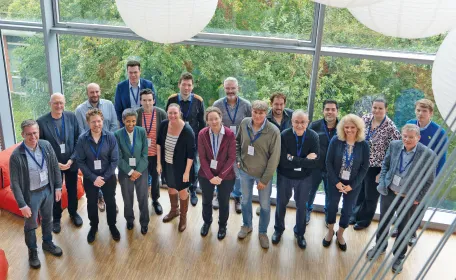Next-generation semiconductors for solar energy harvesting
Solar cells offer a promising approach to carbon-free energy generation, but a wider catalogue of light-absorbing materials is required for higher energy returns. This Focus Group investigated novel metal halide perovskite semiconductors, combining optical spectroscopy, microscopic theory, and material synthesis to examine electric and ionic charge transport as well as optical and vibrational properties that affect performance.

Focus Group: Optoelectronic Properties of Perovskite Semiconductors
Prof. Laura Herz (University of Oxford), Alumna Hans Fischer Senior Fellow (funded by Cluster of Excellence e-conversion) | Dr. Sebastián Caicedo-Dávila (TUM), Postdoctoral Researcher | Hosts: Prof. David Egger (TUM), Prof. Thomas Bein (LMU)
Climate change and energy security are among the greatest challenges for the coming century, leading to renewed research on exploiting the energy of sunlight as a clean and sustainable solution. While single-junction silicon devices are currently the dominant market player, their power conversion efficiency is fundamentally limited to ~30 %. Moving to higher efficiencies will require the stacking of semiconductor layers with different bandgaps, in so-called multi-junction solar cells. As a result, intense activity has focused on creating a new diverse catalogue of inorganic (or hybrid organic-inorganic) semiconductors. These materials have been targeted to enable low embodied energy of production, i.e., low energy payback time for fabricating the light-harvesting device, for example by material deposition from solution or low-temperature vapor deposition. Lead halide perovskites are a prominent example for this class, having shown power conversion efficiencies, in research cells, of more than 26 % in single-junction devices and more than 34 % in tandem with silicon photovoltaics [1]. Intriguingly, this materials class has been found to straddle the boundaries of traditional “hard” inorganic semiconductors (such as bulk silicon) and classic “soft” molecular solids, opening up a complex array of exciting new fundamental science.
This Focus Group has investigated the complex physical and chemical phenomena that underlie the spectacular optoelectronic properties of such perovskite solar absorber materials, with a particular focus on elucidating the effects of material softness. The Focus Group has also explored a range of novel perovskite-like material compositions that show improved properties, with a focus on reduced toxicity and elimination of lead. The Focus Group encompassed a team of complementary experts combining a variety of tools from optical spectroscopy (Herz), microscopic theory (Egger, Caicedo-Dávila), and material synthesis (Bein).
Scientific progress of the Focus Group
Effects of lattice softness and anharmonicity in lead halide perovskites
Halide perovskites show great optoelectronic performance, but their softness results in unusually strong lattice anharmonicity, which leads to novel lattice dynamics that can be hard to capture through traditional computational methods. Understanding such lattice dynamics is critical to photovoltaic material performance, as they govern dynamic disorder, hot-carrier cooling, charge-carrier recombination, and transport. The Focus Group examined such effects through a combination of cutting-edge experimental and theoretical approaches.
In one study (Nature Communications 2024), work by the Focus Group examined the effect of electron lone pairs on anharmonic effects in lead halide perovskites. It was shown that the ns2 electron configuration of octahedral cations is not, as had been previously proposed, a prerequisite for the strong anharmonicity and low-energy lattice dynamics encountered in these materials. The lattice dynamics of CsSrBr3 and CsPbBr3 were compared, i.e., two compounds that are structurally similar but with the former lacking ns2 cations with the propensity to form electron lone pairs. Low-frequency diffusive Raman scattering revealed that low-frequency tilting occurs irrespective of octahedral cation electron configuration, thus ruling out a significant role of lone-pair formation on anharmonicity in lead halide perovskites.
A further study (ACS Energy Letters 2024) examined the ultralow-frequency Raman and infrared terahertz time domain for a wide range of metal halide semiconductors to elucidate the origin of their unusually broad low-frequency Raman response, whose origin is still much debated. Extrinsic defects, octahedral tilting, and “liquid-like” boson peaks were ruled out as causes of the central Raman peak, which was shown to originate from significant broadening of Raman-active, low-energy phonon modes that reflect strong lattice anharmonicity.
Novel low-toxicity, lead-free metal halide semiconductors
The highest-efficiency perovskite solar cells are currently based around materials incorporating toxic lead. The Focus Group therefore explored a range of novel bismuth-based metal halide semiconductors, which offer lower toxicity.
In one study, the Focus Group explored the interplay between charge-carrier localization and material alloying, examining Cs2AgSbxBi1-xBr6 double perovskite thin films (J. Phys. Chem. Lett. 2023, Fig. 1). While initially delocalized charge carriers were found to experience electronic bands formed upon alloying, subsequently self-localized charge carriers probe the energetic landscape more locally. Therefore, the alloy’s low-energy sites (e.g., Sb sites) turn into traps, which dramatically deteriorates transport properties, highlighting the inherent limitations of alloying strategies in materials that spontaneously form self-trapped charges.
Figure 1
A second study (Advanced Optical Materials 2022) explored two-dimensional (2-D) hybrid double perovskites, a class of materials featuring superior intrinsic and extrinsic stability. The Ruddlesden-Popper phases (4FPEA)4AgBiX8 (X = Cl, Br, I) forming double perovskites with different halides and the organic spacer cation 4-fluorophenethylammonium (4FPEA) were examined. Highly oriented thin films were fabricated and investigated spectroscopically, revealing that these systems are dominated by phonon-coupled and defect-mediated polaronic states.
These outcomes inspired further work (JACS 2024) in which electroactive organic cations were combined with inorganic halide perovskites to form layered two-dimensional hybrid materials. By introducing naphthalene and pyrene moieties into Ag–Bi–I and Cu–Bi–I double perovskite lattices, intrinsic electronic challenges of double perovskites were addressed and the electronic anisotropy of 2-D perovskites modulated. Based on the findings, an oriented thin film of (POE)4AgBiI8 was integrated into a device to construct the first pure n = 1 Ruddlesden-Popper 2-D double perovskite solar cell.
Workshop on “Understanding ion migration in solid-state materials for energy applications”
The Focus Group held a workshop at the TUM-IAS in September 2024, which cut across a multitude of scientific disciplines, bringing together leading experimental and theoretical international experts (Fig. 2) working on electronic and ionic transport in solids with relevance to energy applications. A particular focus was on the interplay between light-induced effects and ionic motion, which is still insufficiently understood. Research spanned light-induced ionic motion in photovoltaic materials such as metal halide perovskites and opto-ionic and ionic transport effects in materials for photocatalysis and batteries. A lively, interactive program of 18 keynote talks and discussions provided fertile ground for exchanging ideas and exploring future collaborations among the participants.
Figure 2
[1]
NREL Best Research-Cell Efficiency Chart, www.nrel.gov/pv/cell-efficiency.html, accessed 11 Nov 2024
Selected publications
- Caicedo-Dávila, S., Cohen, A., Motti, S. G., Isobe, M., McCall, K., Grumet, M., Kovalenko, M. V., Yaffe, O., Herz, L. M., Fabini, D. H. & Egger, D. A. Disentangling the effects of structure and lone-pair electrons in the lattice dynamics of halide perovskites. Nature Communications 15(1), 4184 (2024).
- Lim, V. J.-Y., Righetto, M., Yan, S., Patel, J. B., Siday, T., Putland, B., McCall, K. M., Sirtl, M. T., Kominko, Y., Peng, J., Lin, Q., Bein, T., Kovalenko, M., Snaith, H. J., Johnston, M. B. & Herz, L. M. Contrasting ultra-low frequency raman and infrared modes in emerging metal halides for photovoltaics. ACS Energy Letters 9(8), 4127–4135 (2024).
- Hooijer, R., Wang, S., Biewald, A., Eckel, C., Righetto, M., Chen, M., Xu, Z., Blätte, D., Han, D., Ebert, H., Herz, L. M., Weitz, R. T., Hartschuh, A.& Bein, T. Overcoming intrinsic quantum confinement and ultrafast self-trapping in Ag–Bi–I- and Cu–Bi–I-based 2D double perovskites through electroactive cations. J. Am. Chem. Soc. 146, 26694–26706 (2024).
- Righetto, M., Caicedo-Dávila, S., Sirtl, M. T., Lim, V. J.-Y., Patel, J. B., Egger, D. A., Bein, T. & Herz, L. M. Alloying effects on charge-carrier transport in silver−bismuth double perovskites. J. Phys. Chem. Lett. 14(46), 10340–10347 (2023).
- Hooijer, R., Weis, A., Biewald, A., Sirtl, M. T., Malburg, J., Holfeuer, R., Thamm, S., Amin, A. A. Y., Righetto, M., Hartschuh, A., Herz, L. M. & Bein, T. Silver-bismuth based 2D double perovskites (4FPEA)4AgBiX8 (X = Cl, Br, I): Highly oriented thin films with large domain sizes and ultrafast charge-carrier localization. Advanced Optical Materials 10, 2200354 (2022).

